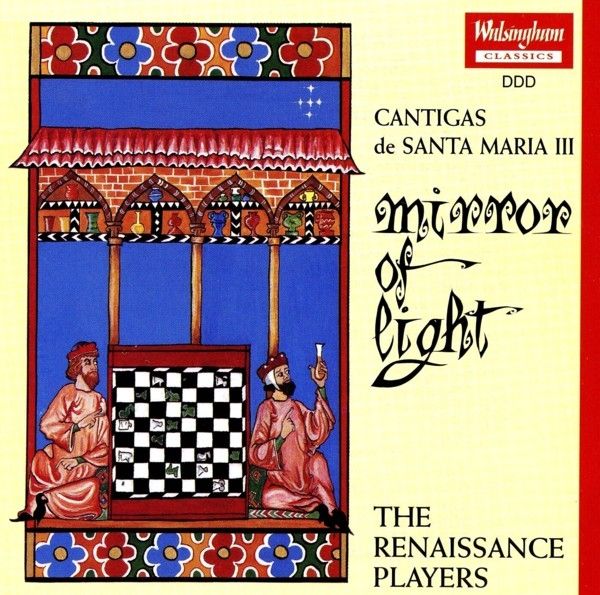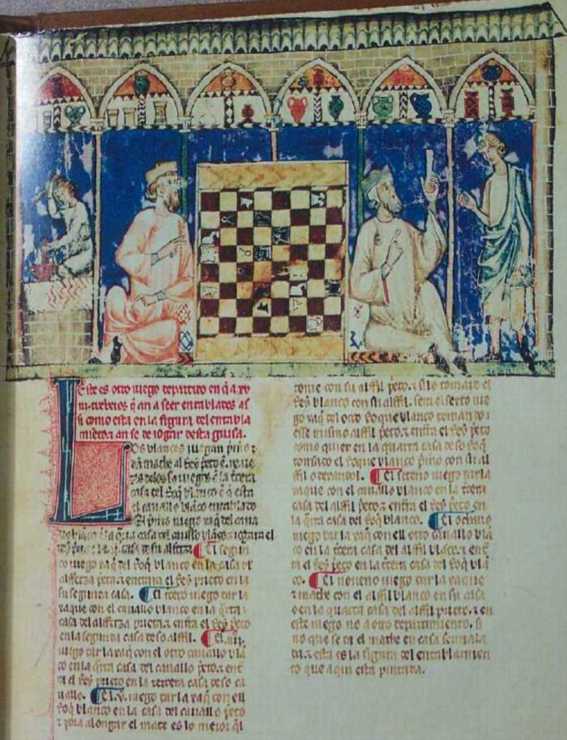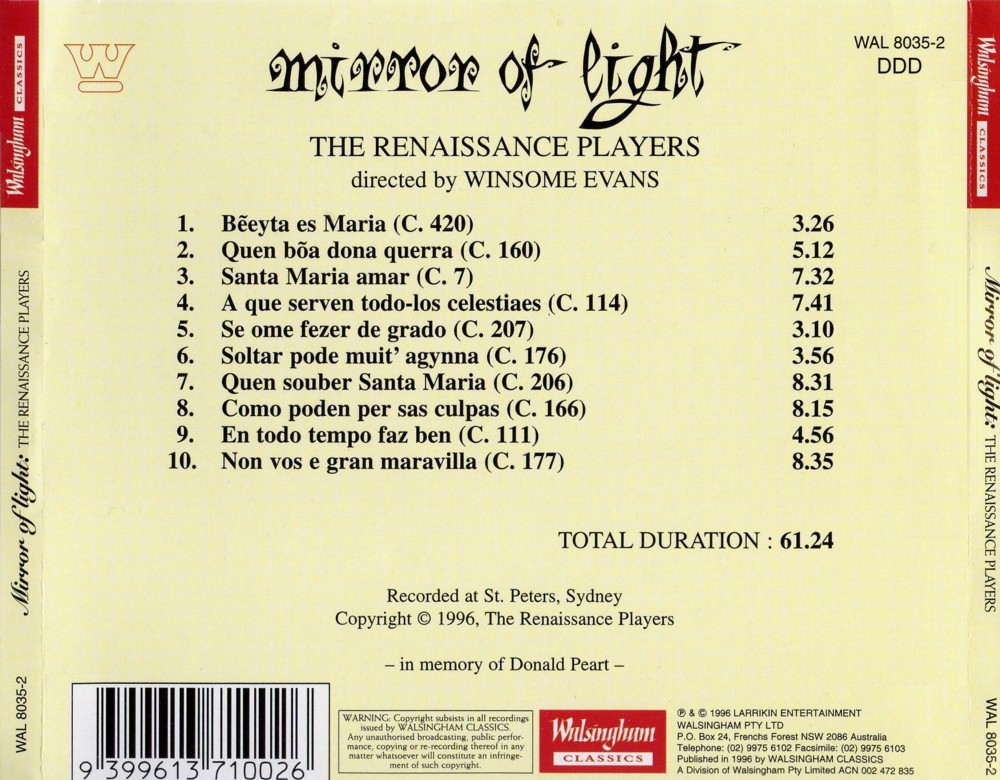
medieval.org
Walsingham WAL 8035-2
1996
Mirror of Light / The Renaissance Players
Cantigas de Santa Maria III

medieval.org
Walsingham WAL 8035-2
1996
1. Bẽeyta es Maria (C. "420")
1. Bẽeyta es Maria [3:26]
CSM 420
Winsome Evans, bells
2. Quen bõa dona querra [5:13]
CSM 160
Chorus | Mara Kiek, alto, tapan | Mina Kanaridis, soprano | Jenny Duck-Chong, mezzo-soprano | Tobias Cole, counter-tenor
Winsome Evans, treble shawms (2), bombarde, bells | Katie Ward, vielle | Benedict Hames, rebec | Andrew Treddinick, ud | Barbara Stackpool, castanets
3. Santa Maria amar [7:33]
CSM 7
Chorus | Mina Kanaridis, soprano | Jenny Duck-Chong, mezzo-soprano
Winsome Evans, harp | Katie Ward, vielle | Benedict Hames, gemshorn | Andrew Treddinick, gittern | Llew Kiek, mandora | Barbara Stackpool, small bells | Andrew Lambkin, bells
4. A que serven todo-los celestiaes [7:42]
CSM 114
Jenny Duck-Chong, mezzo-soprano, tambourine | Mina Kanaridis · Mara Kiek · Tobias Cole, chorus
Winsome Evans, treble shawm | Ingrid Walker, whistle | Katie Ward, vielle | Andrew Treddinick, chitarra moresca | Llew Kiek, baglama | Barbara Stackpool, castanets | Andrew Lambkin, darabukka
5. Se ome fezer de grado [3:12]
CSM 207
Chorus | Mina Kanaridis, soprano | Jenny Duck-Chong, mezzo-soprano | Mara Kiek, alto
Winsome Evans, sinfonye | Benedict Hames, bowed diwan saz | Andrew Lambkin, daireh
6. Soltar pode muit' agynna [3:57]
CSM 176
Winsome Evans, organetto
7. Quen souber Santa Maria [8:33]
CSM 206
Chorus | Jenny Duck-Chong, mezzo-soprano
Winsome Evans, tenor recorder, tambourine | Katie Ward, vielle | Benedict Hames, rebec | Andrew Treddinick, ud | Barbara Stackpool, castanets | Andrew Lambkin, tapan
8. Como poden per sas culpas [8:16]
CSM 166
Chorus | Mina Kanaridis · Jenny Duck-Chong · Mara Kiek, solo voices
Winsome Evans, harp | Katie Ward, vielle | Benedict Hames, gemshorn | Andrew Treddinick, gittern | Llew Kiek, mandora | Barbara Stackpool, castanets | Andrew Lambkin, darabukka
9. En todo tempo faz ben [4:59]
CSM 111
Winsome Evans, psalteries (2)
10. Non vos e gran maravilla [8:33]
CSM 177
Chorus | Mina Kanaridis, soprano
Winsome Evans, alto shawm | Katie Ward, vielle | Andrew Treddinick, chitarra moresca | Barbara Stackpool, castanets | Andrew Lambkin, darabukka

Alfonso X and the Cantigas
Performance problems
The Renaissance Players | credits


As its text states — “Esta decima” — this is the tenth of twelve prefatory cantigas
before the main, dedicatory Prologue of manuscript b.1.2. The number
“420” is borrowed from Walter Mettman's monumental assemblage of all the
texts from the four collections of Alfonso X's cantigas de Santa Maria.
As
a series of benedictions to Holy Mary the second line of every stanza
begins with the word “bẽeyta”. Thus, in our performance the bells play
the textless melody as a jubilus to remind us of the Angelus Domini. There were many customs of worship in the 13th century relating to the Angelus bells. For instance, in 1239 Gregory IX ordered that the evening bell be rung as a salutation to the Virgin Mary; the Chronica XXIV generalium
of 1263 mentions that the Franciscan friars of Pisa encouraged the
people to greet Mary at the sound of the bell; in 1250 Benedict of
Arezzo introduced the custom of having the antiphon Angelus locutus est Mariae
sung at the ringing of the eventide bells; it is recorded in Padua,
1295, that at the striking of the bell all who heard it should genuflect
or, as in Milan, recite the Ave Maria. There were also other related
customs such as reciting three prayers and then striking the bells three
times, or saying three prayers three times a day, and the general
custom of ringing the bells at sunset as a sign of peace.
2. Quen bõa dona querra (C. 160)
The unique structure of this cantiga de loor is contained in eight, three-line stanzas in which the third “line” is the “refrain” (i.e. Santa Maria). As the new trobador for the Virgin Mary, Alfonso has transformed the format of the secular cantiga de amigo (a secular song written by a man speaking as a woman) into a hymn for the Virgin Mary. By using the parallelistic device of lexa-pren (meaning “leave and retake”), the poem builds up a slow-moving and powerful momentum. Lexa-pren
is an interlocking device by which the last line of a stanza becomes
the first line of the next stanza (as seen here with slight
modifications from the second stanza on). Interlocking parallelism was a
common feature of secular cantigas de amigo, particularly by those Galician poets who were masters of the bailada
(dance) forms, such as João Zorro, Pero Moego, Nuno Fernandez Torneol,
Payo Mendinho and Martin Codax (the evocative Vigo-seaside cantigas of the last two are still well-known today).
We
have tried in our performance to reflect the solemn momentum of the
text by progressively adding to the layers of sound, stanza by stanza,
with drone harmonies and organum “fifthing” on Santa Maria. After reaching an ecstatic peak in stanza 8 the singers continue their religious celebration by moving “ad trepudium rotundum” (into a circle dance), disporting themselves loudly and joyfully, but “in a respectful and moderate manner so as not to disturb... with frivolous songs and indecent dances” (as was suggested to pilgrims in the rubrics of the Catalonian Llibre Vermell).
A devotional dance of eight men and four women is still performed today
after the Feast of the Assumption (celebrating Mary's ascent into
eternal glory at her death). In this the dancers move backwards out of
the church to continue the dance outside. Various sizes of shawms are
featured in our instrumentation, an idea derived from the immense
popularity of the cobla bands all over Spain from Galicia to Catalonia.
3. Santa Maria amar (C. 7)
This is one of the six cantigas which tell of
“wayward” nuns who abandon their convents; and one of ten
which refer to the sanctuary of Soissons. In this cantiga, the nun is an abbess whose child is delivered by Holy Mary and sent off “to be reared in Soissons”. The text here refers to several other places - “the man from Bologna”, “the bishop from Cologne” and “the nuns of the Order of Oña” (an order in Burgos reformed in the 11th century by the Cluniacs).
The relatively long æolian melody (a virelai structured A1 A2 b b a1 a2 A1 A2) is played in modal rhythm. The instrumentation is deliberately decorous and gentle. The piece finishes with three “Ave” bells, as a further reminder of Maria, and her wit and discretion in foiling this potential disgrace.
4. A que serven todo-los celestiaes (C. 114)
This is one of eleven cantigas
which tell of miracles performed for those suffering dreadful wounds
and mutilations. The life-giving restoration, performed by the Virgin
Mary for a woman who worshipped in Her church at Salas in Huesca, occurs
on the same day as the killing.
The dorian melody is motivically thrifty. It can be described as A1 B1 a2 a2 a1 b1 A1 B1,
where both “a” melodies start on the mediant and descend, while the “b”
melody starts on the dominant, falls to the lower mediant and ascends
to the upper mediant before it falls to the tonic.
To match the
economical nature of the original melody we have curbed the melodic role
of instruments when the text is sung. Thus instruments only play
melodies when introducing the piece (unmeasured improvisation),
announcing the whole melody as a prelude (shifting from measured to
unmeasured rhythms), giving cues between stanzas, and playing the
postlude, where they are given free rein to embellish heterophonically.
In the final climax, the refrain is sung three times in succession as a
mnemonic form of “Ave”.
5. Se ome fezer de grado (C. 207)
As one of the twenty-four cantigas
about “liberation from penalties due for crimes committed”, this one
finishes with the statue of the Virgin Mary bowing to an extremely
merciful knight, as a commemoration of the special grace of forgiveness.
The story is narrated succinctly in only three stanzas.
In our
rendition we have pared instrumental input to a minimum with the
sinfonye doubling the refrain melody or sharing drones with the diwan
saz. Vocal drones have been used to enrich and vary the texture in the
stanzas and the refrain (where they are fullest). To mark the climax in
the text the last stanza is sung with intensified embellishment and, to
mark the knight's moment of grace, is sung in unmeasured rhythm. Apart
from this, the rest of the cantiga is sung in regular, additive rhythms (short-short-long).
The ionian melody is a virelai in which all phrases consist of melodic pairs with open-closed cadences (that is, A1 A2 b1 b2 a1 a2 A1 A2).
6. Soltar pode muit' agynna (C. 176)
Of the same genre as the previous cantiga,
the text relates a miracle performed, “as I heard tell”, for a
Christian captured by the Muslims. This occurred on the island of
Majorca (“Mayorgas”) when it was under Muslim rule. The Virgin
Mary appears to the prisoner in his dreams and releases him from the
irons fettering his feet, so he can go on pilgrimage to her church at
Salas.
Following the suggestion of the illumination to cantiga 200 (on fol. 185v), cantiga 176 is performed on a small portative organ, the second of the three textless cantigas on this CD. In cantiga
200, which is autobiographical, Alfonso cites a number of personal
favours which the Virgin Mary granted him for which he gives her eternal
praises (“Santa Maria loei e loo e loarei” — “I have, do and will continue to praise Holy Mary”). The intention of the instrumentation is to link the strong sentiments of the two cantigas
— the joy experienced by the released prisoner as he reaches his
pilgrim destination at Salas with the extreme devotion of Alfonso X, the
avowed trobador of Holy Mary.
The dorian melody of this virelai
is made up of pairs of phrases with open and closed cadences.
Unmeasured interludes, a prelude and a postlude are interspersed between
the modal rhythms of the refrain and stanzas. These are occasionally
“disrupted” by the breathing organ as its bellows are recharged — one
hand pumps, the other plays the main melody monophonically or with
drones, parallel fifths and octaves.
7. Quen souber Santa Maria (C. 206)
This cantiga tells the gruesome story of self-mutilation by a guilty pope. Like Non vos e gran maravilla (C. 177), it is one of eleven stories which recount how the Virgin Mary heals people who have been physically wounded.
The dorian melody has a somewhat economical structural format — A1 A2 (a rhyming pair of phrases with open and closed cadences) b1 b1 a3 b2 A1 A2 — in which two melodic incipits (a and b) taper off with varied cadential endings. The “a” phrases all start subdominant to dominant ascending to the upper tonic, and the “b”
phrases start lower tonic to dominant (above which they never rise).
When measured the melody moves in modal rhythms with constant hemiola
accentuations.
The stanzas are grouped in threes. A pattern of
instrumental and vocal cues is established which interlink with the
infrequently occurring refrain. These cues derive conceptually from the
long, improvised prelude which is derived melodically from the incipit of the a melody.
8. Como poden per sas culpas (C. 166)
One of the eight varieties of human affliction cured in the Alfonsine collection of cantigas is lameness or deformity of the limbs and body. Como poden per sas culpas is one of thirteen cantigas
in this category which deals with cripples miraculously restored by the
Virgin. Once cured, the man undertakes a pilgrimage on his newly nimble
legs and feet to Mary's Church at Salas in Huesca. The instrumental
postlude represents the procession of the dancing ex-cripple as he
joyously enters the church and moves to her altar clutching his wax
tribute.
The dorian melody is structured with the following format — A1 A2 b b a1 a2 A1 A2
— and performed in triple metre with regularly patterned hemiola
cross-accentuation. As a prelude, and as a foretaste of the quietly
ecstatic postlude, the original melody is played with improvised
extensions to each of its phrases, followed by unmeasured, alternatim improvisations on motifs a and b.
9. En todo tempo faz ben (C. 111)
This is the third instrumental rendition of a cantiga
melody on this CD (a pattern established throughout our series). The
idea for using pairs of instruments is derived from the illuminations in
b.1.2. Pairs of psalteries, all different in shape and size, are shown
at the masthead of cantigas 40, 50, 60 and 70, and a single, large, bandura-like psaltery is shown atop cantiga 290. The paired psalteries are respectively triangular, trapezoid, pig-snouted and rectangular (the illumination to cantiga
120 in manuscript T.j.1 shows three different psalteries, triangular,
pig-snouted and rectangular, playing together in the ensemble).
Cantiga 111
is one of four tales of resurrection where someone who dies in the act
of sinning, and is thus unable to make confession, is brought back to
life. The twelve stanzas of text (unsung here) tell of a priest who
falls from a boat into the river Seine in Paris and drowns. This
unfortunate accident occurs while he is in disguise on his way to a
clandestine meeting, possibly with a lady friend (like the monk in cantiga
11). For several days he lies in the watery depths until Holy Mary
draws him out so that he is discovered laid out on the river bank, alive
and well.
The mixolydian melody has the simple structure A1 A1 a2 a1 a1 A1 A1 in which all phrases are made up of long or short versions of a.
It has been rhythmicised so that the melody flows without regular
patterns of musical accents. In the improvised preludes and interludes
the psalteries echo and extend in musical dialogue.
10. Non vos e gran maravilla (C. 177)
This cantiga is in the same category as Quen souber
(C. 206) and is a tale about another form of mutilation. The horrific
events take place somewhere in Aragon and the miraculous restoration of
sight occurs in the church of Holy Mary at Salas in Huesca.
The æolian melody, structured ABbbabAB is performed throughout in the quintuple metre of the charrada
(that is, long-short steps). Refrains are preceded by a long, cueing
flourish on the shawm. At the end of the text the singers introduce the
after-dance in praise of Mary with the shrill shout of joy, or “grito viril”, still heard all over Spain where it is known by many different regional names.
All the musical events are structured in fives to commemorate (in our tenth cantiga) MARIA — phrase lengths, metre, overall layout of verses, cue melodies and refrains.
